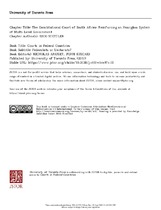The Constitutional Court of South Africa: Reinforcing an hourglass system of multi-level government
Abstract
“The supremacy of the constitution and the rule of law” are two foundational
values of South Africa’s 1996 Constitution (s. 1(c)). An independent
judiciary is thus set to play a major role in interpreting and enforcing the
Constitution. With some significant federal elements in the Constitution,
such as establishing provincial and local orders of government, the courts,
with the Constitutional Court at the apex, are bound to give shape and
texture to this system of government. Since 1995, the Constitutional Court
as well as the Supreme Court of Appeal and High Court have asserted the
supremacy of the Constitution and the separation of powers, establishing
a jurisprudence that gives effect to the principle of limited government.
However, in interpreting the federal arrangements, the Constitutional
Court has not given full effect to the self-rule elements of provincial government.
Instead, it has more often enforced local government’s constitutional
“right to govern, on its own initiative, the local government affairs of
its community” (s. 151(3)). Furthermore, while soft on the substantive content
of provincial self-rule, it has scrupulously policed compliance with the
procedural rules of intergovernmental relations. The Court’s jurisprudence
has given further credence to the hourglass model of multi-level government;
provinces are squeezed thin from the top by a dominant national
government and from below by powerful metropolitan governments.

